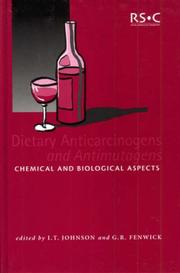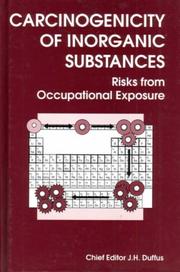| Listing 1 - 10 of 85 | << page >> |
Sort by
|

ISBN: 1845698185 1855737779 9781845698188 9781855737778 0854048154 9780854048151 Year: 2000 Publisher: Cambridge, UK : Royal Society of Chemistry,
Abstract | Keywords | Export | Availability | Bookmark
 Loading...
Loading...Choose an application
- Reference Manager
- EndNote
- RefWorks (Direct export to RefWorks)
Comprehensive and international in content, Dietary anticarcinogens and antimutagens: Chemical and biological aspects includes topics as diverse as the health benefits of tea, wine and beer, through the prevention of various cancers, to the development of effective communication for healthy eating. The book is organised in to sections covering: epidemiology of diet and cancer; mechanisms of DNA damage and repair; the body's various protective mechanisms; and experimental approaches to the study of diet and cancer, with particular emphasis on humans as subjects.
Carcinogens --- Mutagens --- Food --- Toxicology
Periodical
Year: 1987 Publisher: Lyon, France : [Geneva, Switzerland] : The Agency ; Secretariat of the World Health Organization [distributor],
Abstract | Keywords | Export | Availability | Bookmark
 Loading...
Loading...Choose an application
- Reference Manager
- EndNote
- RefWorks (Direct export to RefWorks)
Carcinogens. --- Neoplasms --- chemically induced.
Book
Year: 2018 Publisher: Basel, Switzerland : MDPI - Multidisciplinary Digital Publishing Institute,
Abstract | Keywords | Export | Availability | Bookmark
 Loading...
Loading...Choose an application
- Reference Manager
- EndNote
- RefWorks (Direct export to RefWorks)
Cancer --- Carcinogens. --- Immunotherapy.
Book
ISBN: 9535170104 9535106589 Year: 2012 Publisher: IntechOpen
Abstract | Keywords | Export | Availability | Bookmark
 Loading...
Loading...Choose an application
- Reference Manager
- EndNote
- RefWorks (Direct export to RefWorks)
During the last decades, cancer diseases have increased all over the world. The low quality of food and strong pollution of environment are the main prerequisites for carcinogenesis. The main problem for scientists is to find strategy for prevention of cancer diseases. Therefore, the information about the models for studying carcinogenesis and mutagens which appear during cooking, environmental pollutants, and tests for specific detection of carcinogens is particularly important. The book "Carcinogen" is intended for biologists, researchers, students in medical sciences and professionals interested in associated areas.
Carcinogens. --- Cancer causing agents --- Carcinogenic agents --- Oncogens --- Hazardous substances --- Oncology
Periodical
ISSN: 25384635 Year: 2017 Publisher: Tehran, Iran : West Asia Organization for Cancer Prevention
Abstract | Keywords | Export | Availability | Bookmark
 Loading...
Loading...Choose an application
- Reference Manager
- EndNote
- RefWorks (Direct export to RefWorks)
Cancer Biology --- Cancer Immnulogy --- Carcinogenesis --- Carcinogens --- Cancer genetics --- cancer cell --- cancer biology --- cancer immnulogy --- carcinogenesis --- carcinogens --- cancer genetics --- Cancer --- Cancer.
Book
ISBN: 1283293781 9786613293787 1437778704 1437778690 1455730157 9781437778700 9781455730155 9781437778694 Year: 2008 Publisher: Norwich, NY : William Andrew,
Abstract | Keywords | Export | Availability | Bookmark
 Loading...
Loading...Choose an application
- Reference Manager
- EndNote
- RefWorks (Direct export to RefWorks)
For more than a quarter century, Sittig's Handbook of Toxic and Hazardous Chemicals and Carcinogens has proven to be among the most reliable, easy-to-use and essential reference works on hazardous materials. Sittig's 5th Edition remains the lone comprehensive work providing a vast array of critical information on the 2,100 most heavily used, transported, and regulated chemical substances of both occupational and environmental concern. Information is the most vital resource anyone can have when dealing with potential hazardous substance accidents or acts of terror. Sittig's provides ex
Toxicology --- Industrial toxicology --- Carcinogens --- Cancer causing agents --- Carcinogenic agents --- Oncogens --- Hazardous substances
Book
ISBN: 1789231418 178923140X 1838812954 Year: 2018 Publisher: IntechOpen
Abstract | Keywords | Export | Availability | Bookmark
 Loading...
Loading...Choose an application
- Reference Manager
- EndNote
- RefWorks (Direct export to RefWorks)
Cancer risk factors include exposure to certain substances, which may contribute to the development of cancer. However, substances can have different levels of cancer-causing potential, and the risk of developing cancer is dependent on several factors, including individual genetic background and the amount and duration of the exposure. This book focuses on various cancer risk factors, covering numerous known, probable, and possible carcinogens; their role in carcinogenesis; mechanisms of carcinogenicity; and methods for detecting carcinogens. And due to the growing concerns over the effects that substances and environmental exposures can have on human health, the chapters also emphasize on the vital need for further topic-related research as well as development and implementation of beneficial approaches.
Carcinogens. --- Cancer causing agents --- Carcinogenic agents --- Oncogens --- Hazardous substances --- Medicine --- Medical Oncology --- Oncology --- Health Sciences

ISBN: 9781782424413 1782424415 9781855738003 1855738007 0854044299 9780854044290 Year: 1997 Publisher: Cambridge, England : The Royal Society of Chemistry,
Abstract | Keywords | Export | Availability | Bookmark
 Loading...
Loading...Choose an application
- Reference Manager
- EndNote
- RefWorks (Direct export to RefWorks)
Carcinogens --- Cancer --- Industrial toxicology --- Cancers --- Carcinoma --- Malignancy (Cancer) --- Malignant tumors --- Tumors --- Etiology
Book
ISBN: 0323905609 0323906818 9780323906814 9780323905602 Year: 2022 Publisher: London, England ; San Diego, California ; Cambridge, Massachusetts : Academic press,
Abstract | Keywords | Export | Availability | Bookmark
 Loading...
Loading...Choose an application
- Reference Manager
- EndNote
- RefWorks (Direct export to RefWorks)
"Xenobiotics in Chemical Carcinogenesis: Translational Aspects in Toxicology covers the translational toxicology of xenobiotics substances in carcinogenesis by explaining the toxicokinetic and toxicodynamic, toxicogenomic, biotransformation, and resistance mechanisms in the human body."--
Chemical carcinogenesis. --- Chemical induction of cancer --- Chemical induction of neoplasms --- Chemical induction of tumors --- Chemical tumorigenesis --- Chemically induced cancer --- Chemically induced neoplasm --- Chemically induced neoplasms --- Chemically induced tumor --- Chemically induced tumors --- Carcinogenesis --- Xenobiotics --- Carcinogens --- Carcinogenicity. --- Toxicology. --- toxicity --- Carcinogens. --- toxicity.
Book
ISBN: 9819724244 Year: 2024 Publisher: Singapore : Springer Nature Singapore : Imprint: Springer,
Abstract | Keywords | Export | Availability | Bookmark
 Loading...
Loading...Choose an application
- Reference Manager
- EndNote
- RefWorks (Direct export to RefWorks)
This book draws on a range of intelligent computing methodologies to effectively detect and classify various carcinogenic diseases. These methodologies, which have been developed on a sound foundation of gene-level, cell-level and tissue-level carcinogenic datasets, are discussed in Chapters 1 and 2. Chapters 3, 4 and 5 elaborate on several intelligent gene selection methodologies such as filter methodologies and wrapper methodologies. In addition, various gene selection philosophies for identifying relevant carcinogenic genes are described in detail. In turn, Chapters 6 and 7 tackle the issues of using cell-level and tissue-level datasets to effectively detect carcinogenic diseases. The performance of different intelligent feature selection techniques is evaluated on cell-level and tissue-level datasets to validate their effectiveness in the context of carcinogenic disease detection. In closing, the book presents illustrative case studies that demonstrate the value of intelligent computing strategies.
Gene Expression Profiling. --- Datasets as Topic. --- Artificial Intelligence. --- Carcinogens. --- Neoplasms. --- Artificial intelligence --- Computer science. --- Engineering --- Data Science. --- Theory and Algorithms for Application Domains. --- Data Engineering. --- Data processing.
| Listing 1 - 10 of 85 | << page >> |
Sort by
|

 Search
Search Feedback
Feedback About UniCat
About UniCat  Help
Help News
News